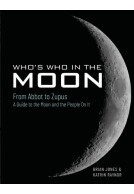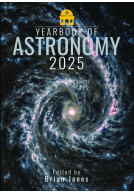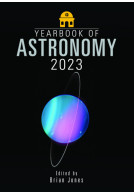Yearbook of Astronomy 2021 (Paperback)
Imprint: White Owl
Pages: 384
Illustrations: 80 colour & black and white illustrations
ISBN: 9781526771872
Published: 6th October 2020
(click here for international delivery rates)
Need a currency converter? Check XE.com for live rates
Maintaining its appealing style and presentation, the Yearbook of Astronomy 2021 contains comprehensive jargon-free monthly sky notes and an authoritative set of sky charts to enable backyard astronomers and sky gazers everywhere to plan their viewing of the year’s eclipses, comets, meteor showers and minor planets as well as detailing the phases of the Moon and visibility and locations of the planets throughout the year. To supplement all this is a variety of entertaining and informative articles, a feature for which the Yearbook of Astronomy is known. In the 2021 edition the reader is presented with articles covering a wide range of topics including Male Family Mentors for Women in Astronomy; Henrietta Swan Leavitt and Her Work; Solar Observing; Obsolete Constellations; Lunar Volcanism; Pages From the Past: Collecting Vintage Astronomy Books; Maori Astronomy in Aotearoa-New Zealand and others.
In addition to the above is the first in a series of articles entitled Mission to Mars: Countdown to Building a Brave New World scheduled to appear in the Yearbook of Astronomy throughout the 2020s. These articles will keep the reader fully up to date with the ongoing investigations, research and preparations that are already underway, as well as those in the planning phase, all of which are geared towards sending a manned mission to Mars at or around the end of the decade. We are at the start of what promises to be an exciting journey.
The Yearbook of Astronomy made its first appearance way back in 1962, shortly after the dawning of the Space Age. Now well into its sixth decade of production, the Yearbook is rapidly heading for its Diamond Jubilee edition in 2022. It continues to be essential reading for anyone lured and fascinated by the magic of astronomy and who has a desire to extend their knowledge of the Universe and the wonders it plays host to. The Yearbook of Astronomy is indeed an inspiration to amateur and professional astronomers alike, and warrants a place on the bookshelves of all stargazers and watchers of the Universe.
Rating: 5 out 5 stars
NetGalley, Rob Dale
This is a great reference for those who enjoy looking at the stars! Appropriate for all ages and all levels of science background… You just need a passion for the sky.
Incredibly informative, both for the amateur and semi-pro astronomer. Anyone who loves looking at the sky should have a copy of this book.
NetGalley, Meredith Reid
Everything you need to know about the night sky - this annual publication is second to none for astronomical information!
Books Monthly
Wow, what a lot of information all in one book! Eclipses, star positions, phases of the moon, comets and meteor showers appearing in 2021 and so much more. Fascinating for someone like me who likes to gaze at the moon and stars. Now, I will be so much more informed as to what I’m actually looking at!
Amazon Customer, Jayne
The month by month guide is so useful and guarantees that I will be dipping into the book time and time again during 2021. Plus, the articles in the second half of the book are so interesting and a handy glossary at the end means that readers need not be phased by some of the terminology used. Great stocking filler for a star gazer!
Read the full review here
For me, the Yearbook of Astronomy fits in perfectly with how I look towards space. I like to know when certain events are going to take place (and try and plan my days / nights around these) so knowing a year in advance of when everything is going to occur is a huge bonus for me... everyone who looks towards the stars will find one thing of use in this yearbook.
NetGalley, Danielle Price
The Yearbook of Astronomy 2021, edited by Brian Jones with over 20 contributing authors, is the latest publication of this yearly reference book that started in 1962. As an armchair/backyard astronomer, I felt like this book was written for me. The sky charts and monthly description of astronomical events and what to look for when sky gazing in 2021 are well done, if slightly redundant in this age of easily accessible planetarium software. The strength of this reference is in the many well written and informational astronomy articles that it contains. These articles are both educational and interesting. Topics include the history of astronomy and famous astronomers, space related accomplishments from the previous year, and planned space exploration in the coming years. The detailed observation lists and descriptions regarding meteors, comets, planets, asteroids, variable stars, double stars, deep space objects, etc gave me encouragement to grab my telescope and head out to a dark viewing spot! I particularly enjoyed the articles on solar observation, early artifacts made from meteorite metals, the history of constellation naming, the geological history of the moon, and Maori astronomical history. Finally, the comprehensive glossary will serve as a useful reference to the occasional technical term.
NetGalley, S Trent
This book will appeal to the kind of reader that likes astronomy magazines, and I definitely recommend this to the hobbyist astronomer that enjoys reading and learning about astronomy.
Rating: 5 out of 5 stars
NetGalley, Victoria Caswell
The Yearbook of Astronomy made its first appearance way back in 1962, shortly after the dawning of the Space Age. Now well into its sixth decade of production, the Yearbook is rapidly heading for its Diamond Jubilee edition in 2022. It continues to be essential reading for anyone lured and fascinated by the magic of astronomy and who has a desire to extend their knowledge of the Universe and the wonders it plays host to.
When I saw this book up for request, I knew I had to. Since the beginning of the year with all the world happening right now, Astronomy has been something I’ve delved into and enjoyed and hope to carry on and this book certainly is going to help. Packed with every date and transition you need to be a keen astronomer, it’s a really good guide for a rookie like figuring it out and a pro who just needs a place to find all you need about the night skies.
Inbetween each month’s planetary calendar, are really interesting articles. ‘The Star That Was Older Than The Universe’ was a really intriguing read about ‘HD140283′ known as ‘The Methusulah Star’ due to its incredible age. Another really interesting piece in this book includes ‘Your Name In Space’ about the history of sending your name into space, with millions of people’s names being put on a chip or a disk and sent to distant planets (I know I have my own ’boarding pass’ for the 2020 mission to Mars myself!).
In the second half of of the book are longer articles on anniversaries going on in the year, the work of Henrietta Leavitt and her incredible contributions that led to discoveries by Shapley and on to Hubble and the article on Maori Astronomy is also another interesting read.
A really great guide to the skies of 2021, if you’re an astronomer, this is a great book to have handy next year and highly recommend it!
Rating: 5 out of 5 stars
NetGalley, Jennifer Capson
I thought this Yearbook of Astronomy would be a light read with mostly pictures and fun facts. I was wrong. It was a highly informative and useful book about many topics including Moon phases and Constellations. I thought I had a base knowledge of Astronomy but I was mistaken. This book has provided me with useful information and I learned a lot. I was very pleased to learn that this annual yearbook has been published for decades and I look forward to reading this every year.
The book was very informative and gave a lot of history and information I did not know.
NetGalley, Meredith Johnston
Rating: 5 out of 5 stars
NetGalley, Dawn Lewis
I was about 10 pages into this book when it hit me: I couldn't NOT have a physical copy of this book, so I went ahead and pre-ordered! I feel a bit stupid really, because this book is exactly what I have been wishing existed... and it does exist, and has done for quite a few years. Aside from the priceless star maps (which are really simple to use once you get yourself pointed in the right direction!), you're offered an abundance of information (in an easy to read and well-laid out manner) on all sorts of interesting things like comets, planets, meteor showers, space exploration... the list goes on and on, all packaged up in a truly beautiful and user-friendly book. Get in touch if you want to hear me rave a little more about "Yearbook of Astronomy 2021"!
This is a book I would love to go back too during the year to see what is coming in term of astronomical even, look at the sky charts and just find and use information to try and see great stuff with my telescope. I also like the more general information about astronomy that help you build some knowledge on the subject. I would recommend it to young astronomers like me!
NetGalley, Patricia Maheux
About Brian Jones
Brian Jones hails from Bradford in the West Riding of Yorkshire and was a founder member of the Bradford Astronomical Society. He developed a fascination for astronomy at the age of five when he first saw the stars through a pair of binoculars, and his interest took him into the realms of writing sky guides for local newspapers, appearing on local radio and television, teaching astronomy and space in schools and, in 1985, becoming a full time astronomy and space writer. He has penned around 20 books to date which have covered a range of astronomy and space-related topics for both children and adults. His passion for bringing an appreciation of the universe to his readers is reflected in his writing.




















